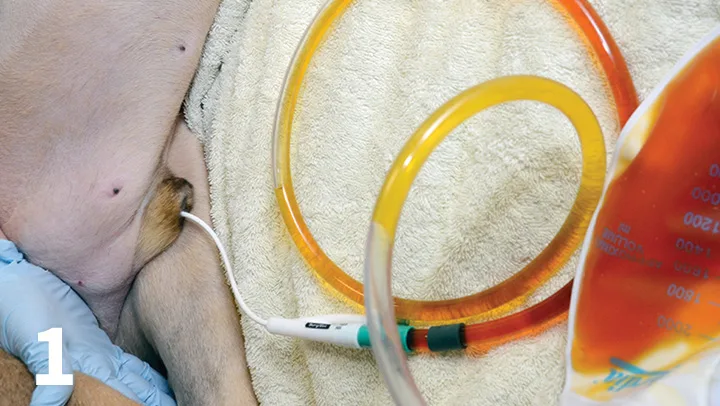Urinary Catheters & Infection
Kelly E. O'Neill, DVM, DACVIM (SAIM), St. Francis Veterinary Specialists
Mary Anna Labato, DVM, DACVIM (SAIM), Cummings School of Veterinary Medicine at Tufts University

You have asked...
How should I best manage indwelling urinary catheters in dogs and cats?
The experts say...
Indwelling urinary catheters are important in the management of patients with a variety of underlying conditions, including upper and lower urinary tract diseases, trauma, and orthopedic and neurologic dysfunction. However, indwelling urinary catheter use can be associated with nosocomial infections. The use of these catheters can lead to increased morbidity, including drug-resistant infections and pyelonephritis in some patients.1
Barricade to Infection
In healthy individuals, a variety of natural defenses prevent bacteria from establishing an infection; these defenses include periodic emptying of the bladder, sloughing of urinary epithelial cells, and the protective epithelial layer of mucus. If bacteria are present, the urinary system creates an inhospitable environment by initiating bodily immune responses, decreasing availability of iron (necessary for bacterial growth), creating a low pH and high osmolality environment, and increasing urea concentration.2 The acidity, osmolality, and presence of urea decrease survival of bacterial pathogens.3
A urinary catheter disrupts the body’s natural defenses against infection.
Placement of a urinary catheter disrupts the body’s natural defenses against infection. Foley catheters traumatize and erode the protective glycosaminoglycan layer and mucosal lining of the bladder.3 Catheters can harbor bacteria in the narrow lumen and along their rough and irregular surfaces, promoting bacterial adhesion and colonization. In this way, the urinary catheter functions as a nidus for ongoing release of bacteria into the bladder.4
Related Article: Biofilms & Urinary Tract Infections…A Sticky Situation
Bacteria can colonize catheters through extra- and intraluminal routes. Extraluminal routes are most common because bacteria can be introduced at the time of catheter insertion and during routine patient care. These bacteria are primarily endogenous and usually originate in the patient’s GI tract. Bacteria that ascend into the bladder intraluminally are typically introduced after the catheter is in place.5,6 Use of a closed urinary collection system helps to limit intraluminal contamination.7
Bacteria introduced through contamination from the hands of healthcare workers are less common, but the bacteria transmitted via this route can be more difficult to treat.
Related Article: Urethral Catheterization of the Female Dog & Cat
Catheter-Related Infections in Dogs
The most common bacteria isolated in dogs with urinary tract infections (UTIs) is Escherichia coli, followed by Staphylococcus and Enterococcus species. A recent evaluation of 1028 dogs with UTIs found that 52.5% had E coli infections.8 However, dogs with a urinary catheter may have different bacteria involved in UTIs when compared with noncatheterized dogs.
In 1 study, dogs with catheters more frequently developed infections with Enterobacter or Staphylococcus species; Escherichia and Proteus species were more commonly isolated from noncatheterized dogs.1
Bacteria are often found in the urine of catheterized animals, but it is important to distinguish between subclinical bacteriuria and infection. In the absence of signs of infection or gross abnormalities of the urine, bacteriuria is not a cause for alarm; however, if clinical signs (eg, fever) are present, infection should be suspected, and the urine should be examined for evidence of pyuria.9
Studies of hospitalized dogs with indwelling urinary catheters show bacteriuria rates ranging from 10% to 48%.1,10 Risk factors for bacteriuria include increased patient age, length of time the catheter is in place, and concurrent use of antibiotics. Specifically, the likelihood of developing bacteriuria increased 20% with each year of age, 27% with each day the catheter was left in place, and 454% with antibiotic use.1
The reason for these findings is not straightforward and may be the result of reductions in protective commensal bacteria or possible concurrent antibiotic use for patients with secondary infection sources elsewhere in the body.1,15 In addition, longer antibiotic use allows time for bacteria to develop resistance patterns and encourages colonization.11 Despite these findings, the risk for UTI has been shown to be relatively minimal if the catheter is left in place for fewer than 3 days, especially if appropriate steps are taken to maintain cleanliness.10
Catheter-Related Infections in Cats
Cats appear less likely to develop UTIs than dogs. Studies have shown that 2% to 12% of urinary tract diseases in cats are caused by bacterial infection; the presence of occult bacteriuria may also be less common in cats than in dogs.11 Placement of urinary catheters in cats is common, especially for relief and treatment of a urethral obstruction; however, few studies have examined the incidence of infection that may develop as a result.
Related Article: Urinary Catheter Placement for Feline Urethral Obstruction
A recent study showed that 33% of catheterized cats developed significant bacteriuria during catheterization; these were primarily endogenous GI bacteria, including E coli and Staphylococcus species.12 In addition, 1 study found that urinary catheter use is associated with the development of multidrug resistant (MDR) UTIs. In 1 UTI study, 26.9% of cats with an MDR E coli urinary infection were found to have a history of a urinary obstruction that was treated with catheterization.10
Tips for Reducing Risk for Catheter-Associated Infection13
Place a urinary catheter only when needed.
Decreased mobility of the patient because of recent trauma or surgery
Need to closely monitor urine output (eg, oliguria, polyuria)
Need to prevent bladder distention
Educate all personnel in appropriate catheter placement techniques with an emphasis on asepsis.
Stress handwashing before and after handling of catheter or urine- collection system.
Gloves should be worn when emptying or manipulating the catheter.
Closed collection systems should be utilized with drainage available through a distal port, not from the catheter connection site (Figure 1).
Figure 1. A closed urinary collection system should be used to prevent external contamination.

When emptying the urine collection bag, gloves should be worn, and the evacuation port should be wiped with a dilute chlorhexidine solution.
Based on the authors’ clinical experiences, including a high incidence of UTIs associated with indwelling urinary catheters in the hospital setting, replace urinary catheter every 48 hours—sooner if gross contamination is noted.
Since starting this protocol, fewer infections have been reported.
If the catheter is no longer needed, it should be removed immediately.
Other reasons to remove a catheter early include excessive kinking of the outflow line or other obstruction to urine flow through the system.
If possible, avoid antibiotics while the patient has an indwelling urinary catheter.
If there is a change in the appearance, such as increased cloudiness or hemorrhage, a strong odor, or if the patient develops signs of infection (eg, fever, leukocytosis), urine collected via cystocentesis should be evaluated for the presence of bacteria.
Urine should not be collected from the collection bag or urinary catheter for evaluation, as the presence of bacteria in the collection system may not reflect true infection if bacteriuria, culture, and susceptibility of urine should be performed.
Clean the outside of the penis or vulva and external catheter and collection line every 4 hours with a dilute chlorhexidine solution (Figure 2).
Figure 2. The outside of the collection system should be visually evaluated and cleaned every 4 hours with a dilute chlorhexidine solution.

Gloves and aseptic technique should be followed for catheter removal.
The urinary catheter bulb should be fully deflated and the catheter carefully removed from the patient.
Culture of the catheter tip is not recommended, as this is not predictive of UTI risk.
All patients with a history of urinary catheterization should be monitored for any signs of UTI.
These signs may include pollakiuria, hematuria, stranguria, or fever.
If signs of a UTI are present, urine should be collected via cystocentesis for evaluation and culture and susceptibility testing.
Conclusion
A urinary catheter is beneficial to many veterinary patients, but it can also contribute to increased risk for infection. Judicious patient selection and conscientious management can decrease the risk for morbidity associated with their use.
MDR = multidrug resistant, UTI = urinary tract infection